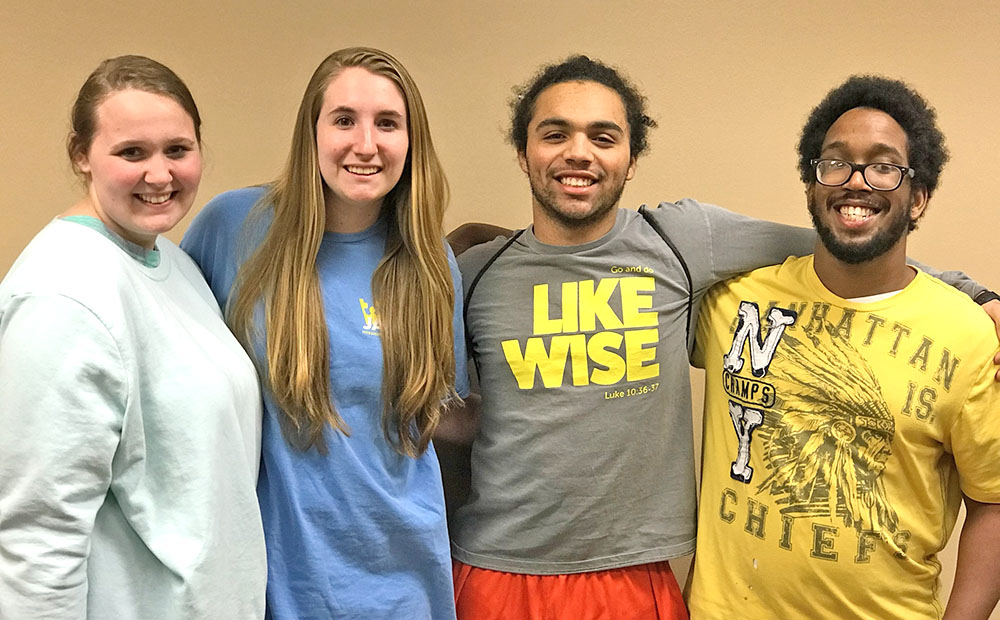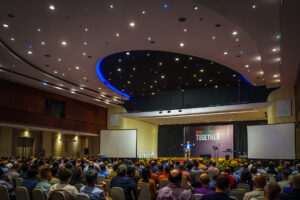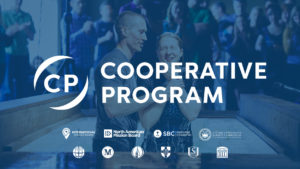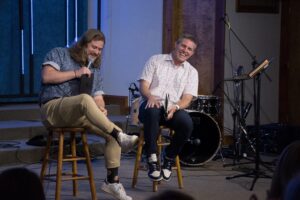
HOUSTON (BP) — Even after an EF-3 tornado — one of 13 tornadoes to strike northern Alabama March 19 — ripped through their college campus, tearing roofs off dorms, downing trees and damaging cars, Jacksonville State University students elected to remain in Houston to help hurricane victims rather than returning to assess their own damaged living spaces.
 It was not the spring break most expected. Then again, perhaps it was, at least in terms of mission and camaraderie.
It was not the spring break most expected. Then again, perhaps it was, at least in terms of mission and camaraderie.
The 28 JSU students and sponsors deployed to Houston with the North American Mission Board’s Send Relief/GenSend initiative. They joined 320 college students from across the nation to spend one of three spring break weeks in Texas rebuilding neighborhoods devastated last September by Hurricane Harvey.
While Alabama Gov. Kay Ivey declared a state of emergency back home, the JSU students learned of their state’s plight. Gary Brittain, JSU Baptist Campus Ministries (BCM) director, asked the group what they wanted to do.
They voted to stay in Houston, while Brittain and three students returned to Alabama to check on the college.
Peggy Colbert of Calhoun, Ga., marveled at the students’ determination to finish the job. She served as NAMB site director at Champion Forest Baptist Church in Northwest Houston where the GenSend volunteers were housed.
“Some had lost everything in their dorm rooms. Most knew nothing about their cars from the hailstorm, and they stayed working every day,” Colbert said.
Their work involved replacing sheetrock, and taping and mudding seams. Few students had prior construction experience, but they learned on the job, supervised by experienced disaster relief (DR) construction crew chiefs.
“They don’t know what they are going back to,” Colbert said of the group’s scheduled March 23 departure.
The students’ story has not gone unnoticed, Colbert added, noting that members of the group had been interviewed by local news outlets.
“They are an incredible group of students, committed to God,” she said.
The JSU students were not the only ones sacrificing their vacations,” Colbert noted, explaining that over the three-week GenSend initiative, 31 crews of 10-12 college students worked out of Champion Forest. Colbert served as site director all three weeks.
“To think they would pay to come sleep on the floor of a church to work on houses during their spring break, incredible,” Colbert said of the students from 15-20 colleges from the Pacific Northwest to New York and New England.
“Some didn’t know what a hammer was before they came, and they most certainly did not know what a trowel was or a T-square,” Colbert chuckled.
“We were quick learners,” said JSU sophomore Olivia Willoughby of Huntsville, Ala., whose crew worked on two houses. Willoughby said staying in Houston was an easy decision.
“The city [Jacksonville] has a curfew. If we went back, there was really nothing we could do to help. Here we can be productive. It really helps take our minds off what we will confront when we drive back,” Willoughby said.
“We had seen the pictures [of JSU]. We knew how bad it was. We all realized there was nothing to do there. It was pointless to go back when there’s people who need help,” said JSU freshman Elizabeth Rains of Scottsboro, Ala., whose dorm was damaged.
Caleb Howell of Alexandria, Ala., said he lives at the BCM and confirmed the property had suffered uprooted trees, roof damage, interior water damage and the loss of a tool shed.
Brandon Stevens, from Alexander City, Ala., is a JSU sophomore on his second mission trip despite dealing with cerebral palsy. He said such experiences will continue to figure in his future.
“I want to be able to help Jacksonville every way I can,” Stevens said, calling his “new skills” of sheetrock installation and mudding both useful and “interesting.”
Colbert said she overheard Jacksonville students remarking how their newfound abilities will allow them to help restore their campus and town.
Steve Turner, NAMB’s senior director of next generation mobilization, called the overall Houston effort, “a wonderful partnership between churches, SBDR (Southern Baptist Disaster Relief), the SBTC (Southern Baptists of Texas Convention) and Send Relief to bring students to the city bringing help and hope to those affected by Harvey.”
DR feeding crews from the SBTC prepared meals for the Houston GenSend volunteers.
NAMB GenSend spring initiatives also deployed students to Puerto Rico and Immokalee, Fla. For more information, visit sendrelief.org/disaster-response/collegiate-disaster-response/.
GenSend volunteers were not the only collegians to assist Harvey victims over spring break, said Brandon Reed, SBTC DR consultant who coordinated operations out of First Baptist Church of Humble.
In addition to the student volunteers at Champion Forest, InterVarsity Christian Fellowship groups from the Northeast sent 150 students to Humble, north of Houston, where they were housed at FBC Humble. Members of the church prepared and served meals for the volunteers.
InterVarsity brings non-Christians on outreaches, Reed said, explaining the organization seeks a “50 percent believer to non-believer ratio for the purpose of discipleship so non-Christians can see life lived out.”
Some of the non-believers accepted Christ, Reed said, describing Stephanie, a New England coed who saw something different about “these Christians, the way they operate and do things,” that drew her in.
“As a result of seeing God work through this rebuild process and sensing God at work in her own heart, she accepted Christ,” Reed noted.
InterVarsity groups completed 37 work orders, helping the helpless and hopeless, such as Yvonne Price, a 78-year-old widow who contacted Reed for help months earlier. Finally, this March, sufficient resources and student labor were in place to fully insulate and drywall Price’s home, which had been stripped to the studs.
“For most of these homes, if the students and volunteers aren’t available, the work won’t be done,” Reed said. “These folks don’t have the funding or resources to do it on their own.”
Pat Brightwell, a Humble-area widow in her mid-sixties thought she was out of options and planned to sell what was left of her home.
“Something told her not to,” Reed said, explaining that students reconstructed Brightwell’s kitchen and painted, enabling her to again occupy the house she thought was lost forever.
“This is home again,” Brightwell told volunteers.
















